Since the Carbon Pollution Reduction Scheme White Paper was released on Monday, I have been perplexed.
It had all been going so well. Kevin Rudd (my Facebook friend) fulfilled my little heart’s desires when he ratified the Kyoto Protocol. After seeing Penny Wong speak in London, I was so impressed that I adopted her as my hero.
But now this — the unconditional 5% by 2020 greenhouse gas emissions reduction target. Five per cent? Did I hear correctly?
On the face of it, it seems so pitiful, so unambitious. I didn’t understand! And until I understood Kevin and Penny’s rationale, I would withold condemnation.
Today, I read through the executive summary and selected chapters of the White Paper.
Now I understand.
Before anyone protests or supports this scheme and its target, please, please take the time to read at least the executive summary to understand the key details. (In fact, I beseech you to do this for any issue on which you wish to express an opinion.)
5% from what baseline?
My first question was what the baseline year for the 5% reduction was. The Kyoto Protocol and European Union policies (with which which I am most familiar) are based on 1990 emissions. So when the UK says it’s aiming for a 26% reduction by 2020, it’s compared to the 1990 baseline year.
Our 5% target is from a 2000 baseline year. After looking through our greenhouse inventory and the ABS, it turns out that this is not much different to the 1990 year (although the Australian Government have argued that 2000 is a more challenging baseline).
| Year
| Net greenhouse gas emissions
(tCO2e)
| Australian population
| Net greenhouse gas emissions per capita
(tCO2e/capita)
|
| 1990
| 552 648 000
| 17 million
| 33
|
| 2000
| 552 813 000
| 19 million
| 29 |
tCO2e — tonnes of carbon dioxide equivalent. Other greenhouse gases are converted into the same global warming impact as a tonne of carbon dioxide. For example, over 100 years, methane is 25 times more potent than carbon dioxide so one tonne of methane is 25 tCO2e.
Why our 5% is worth their 20%
The Government believes that a 5% cut by Australia represents the same effort as the European Union’s 20% cut because of this key point: Australia’s population will grow by 45% between 1990 and 2020, while the EU’s growth has flatlined during the same period. You can see how it is harder to stabilise (or reduce) emissions while your population grows. Each additional person will produce additional emissions through his or her direct consumption (electricity, heat, food, goods) and employment activitiy.
So the logic is that if Nations A and B set the same target, and Nation A’s population doubles, then Nation A has to work twice as hard as Nation B to achieve the same absolute reduction in emissions.
Table E1 of the White Paper executive summary compares Australia’s total and per capita reduction commitments with those of the EU, the UK and USA. I’ve reproduced it here.
| Country
| 2020 targets
| 2020 per capita reduction
|
2050 targets
|
| Australia
| 5-15% below 2000 levels (4-14 per cent below 1990 levels)
| 27-34% below 2000 levels (34-41% below 1990 levels)
| 60% below 2000 levels (60% below 1990 levels)
|
| European Union
| 20-30% below 1990 levels
| 24-34% below 1990 levels
| 60-80% below 1990 levels
|
| United Kingdom
| 26% below 1990 levels
| 33% below 1990 levels
| 80% below 1990 levels
|
| Proposal
|
|
|
|
| United States (proposal of President-elect Obama)
| Return to 1990 levels
| 25% below 1990 levels
| 80% below 1990 levels |
60% by 2050
The White Paper states that the Government is still committed to reducing emissions by 60% by 2050 (presumably from the 2000 baseline). This is in line with the EU and, until recently, the UK (who just this month set itself an 80% target by 2050). I am not sure how the Government expects to ramp up from 5% to 60% reduction over 30 years, and I will be looking at the strategy if/when it is released. However, I believe that getting the emissions trading scheme established is an important structural change to the economy. It could be the thin edge of a giant wedge of change.
20% renewables by 2020
I was worried that the 5% target would not be big enough to transform the energy market to support competitive renewables. Although emissions trading is the Government’s main climate change mitiation measure, I am relieved that there is a separate target for renewable energy — 20% of electricity supply by 2020. This isn’t as ambitious as it could be but at least the commercialisation of renewable energy is recognised as a strategy to be specifically managed.
Credit where credit’s due
I wish to give credit where credit is due. When it is implemented, Australia’s Carbon Pollution Reduction Scheme (CPRS) will the broadest in the world. Below, I’ve compared it to the world’s first scheme, the European Union Emissions Trading Scheme (EU ETS).
|
| Australia CPRS
| EU ETS phase 1 (2005-2007)
| EU ETS phase 2 (2008-2012)
|
| Coverage of greenhouse gas emissions
| 75%
| 40%
| 46%
|
| Participating sectors
| Energy activities, transport, leakages/losses, industrial processes, waste and forestry*
| Energy activities, ferrous metal and mineral industries, pulp, paper and board activities
| As for phase 1, plus a number of new industries (e.g. aluminium and ammonia producers)
|
| Greenhouse gases included
| All six Kyoto Protocol gases — carbon dioxide, methane, nitrous oxide, sulfur hexafluoride, hydrofluorocarbons, and perfluorocarbons
| Carbon dioxide
| Carbon dioxide, nitrous oxide and perfluorocarbons |
* Excludes agriculture and deforestation (17% and 10% of emissions in 2000, respectively)
It is useful to note that the aim for Phase 3 of the EU ETS (post-2012) is to cover all greenhouse gases and all sectors, including aviation, maritime transport and forestry.
In non-conclusion
My quick review of the White Paper has led me to conclude that the Government’s proposal is defensible in terms of international standards for action on climate change.
However, please note that I have made no comment on:
- the justness or effectiveness of relying on a (single) market-based approach to reducing greenhouse gas emissions;
- the adequacy of the targets set by the EU, UK and US (to which Australia claims parity); or
- the reliability, desirability or controllability of the population projections that have led the Government to its small absolute target.
But I am relieved that there is a logical basis for the 5% target, which I can now explain to those people who are equally perplexed as I was.
Bibliography
Australian Bureau of Statistics (2001), ‘A century of population change in Australia’, Year Book Australia: 2001, catalogue number 1301.0, available online here, accessed on 18 December 2008
Australian Bureau of Statistics (2002), ‘Population size and growth’, Year Book Australia: 2002, catalogue number 1301.0, available online here, accessed on 18 December 2008
Carbon Trust (date not given), ‘The EU Emission Trading Scheme’, last update not given, Carbon Trust website, available online here, accessed on 18 December 2008
Carrington D (2008), ‘Australia pledges to cut emissions by up to 15%’, The Guardian, 15 December 2008, available online here, accessed on 18 December 2008
Department of Climate Change (2006), ‘Australia’s National Greenhouse Accounts’, 2006 inventory year, online emissions database available here, accessed on 18 December 2008
Department of Climate Change (2008a), Carbon pollution reduction scheme: Australia’s low pollution future, White Paper, 15 December 2008, available online here, accessed on 18 December 2008
Department of Climate Change (2008b), ‘Australia’s renewable energy target’, Department of Climate Change website, last updated 17 December 2008, available online here, accessed on 18 December 2008
Dimas S (2005), ‘EU climate change policy’, speech at the Conference of National Parliaments of the EU and the European Parliament, 21 November 2005, available online here, accessed on 18 December 2008
European Commission (2008), ‘Questions and Answers on the Commission’s proposal to revise the EU Emissions Trading System’, press release, 23 January 2008, available online here, accessed on 18 December 2008









